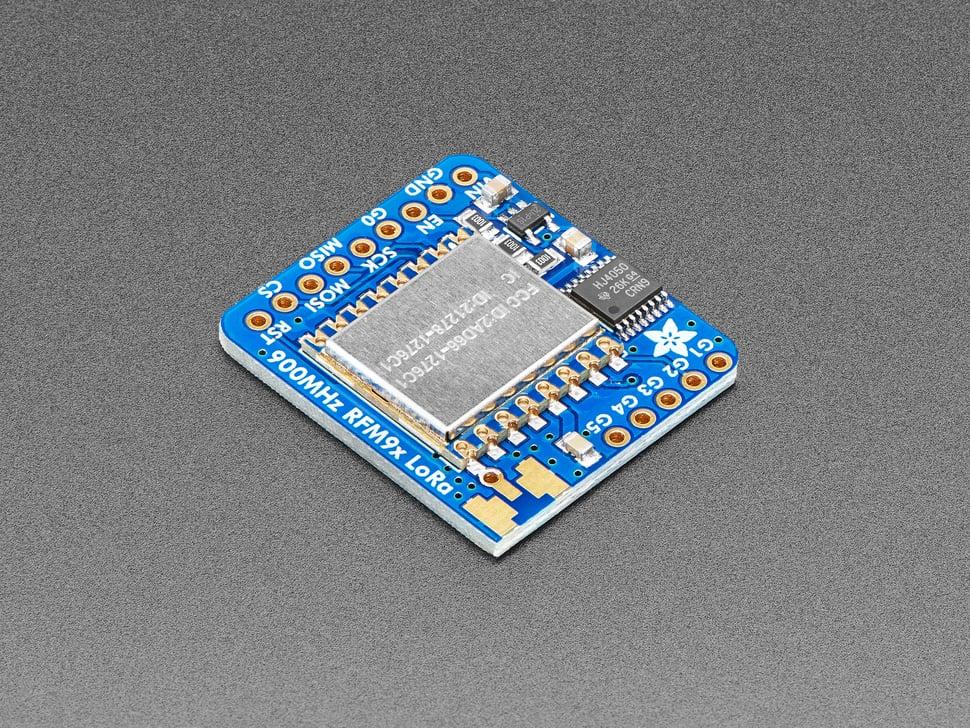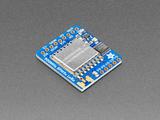Adafruit RFM95W LoRa Radio Transceiver Breakout - 868 or 915 MHz

Description
Sending data over long distances is like magic, and now you can be a magician with this range of powerful and easy-to-use radio modules. Sure, sometimes you want to talk to a computer or perhaps communicate with a phone, but what if you want to send data very far? Most WiFi, Bluetooth, and other wireless chipsets use 2.4GHz, which is great for high-speed transfers. If you aren't concerned about streaming a video, you can use a lower license-free frequency such as 433 or 900 MHz. You can't send data as fast, but you can send data a lot farther.
These packet radios are simpler than WiFi or BLE. You don't have to associate, pair, scan, or worry about connections. Just send data whenever you like, and any other modules tuned to the same frequency will receive it. The receiver can then send a reply back. The modules handle packetization, error correction and can auto-retransmit, so you don’t have to worry about everything, and less power is wasted on maintaining a link or pairing.
These modules are great for use with Arduinos or other microcontrollers, perfect for sensor node networks or transmitting data over a campus or town. The trade-off is you need two or more radios with matching frequencies. These radio modules come in four variants: two modulation types and two frequencies. The RFM69s are the easiest to work with, while the LoRa radios are exciting and more powerful but slightly pricier. This 900 MHz radio version can be used for either 868MHz or 915MHz transmission, tunable dynamically through software.
We also carry a 433 MHz version here. These are +20dBm LoRa packet radios with special modulation that isn't compatible with the RFM69s but can go much farther. They can easily reach 2 km line of sight using simple wire antennas or up to 20 km with directional antennas and settings tweaks. These radios use the license-free ISM band, "European ISM" @ 868MHz or "American ISM" @ 915MHz, and can utilize a simple wire antenna or offer spots for uFL or SMA radio connectors.
This device uses the SX1276 LoRa-based module with an SPI interface, providing a power output selectable in software, from +5 to +20 dBm, up to 100 mW. It consumes about 100mA peak during +20dBm transmission and about 30mA while listening. All radios are sold individually and can only communicate with radios of the same part number. Each radio is equipped with a header, a 3.3V voltage regulator, and a level shifter to handle 3-5V DC power and logic, versatile for 3V or 5V devices. Some soldering is required to attach the header and create your antenna, with the optional choice of an external duck via a uFL or SMA edge-mount connector.
Properties
| Brand | Adafruit |
| Model | 3072 |
Delivered in 10 to 30 days
Customer questions
Customer Reviews
- In stock Adafruit NOOds - Flexible LED Filament - 3V 300mm long - Red € 8,75 View product
- In stock Adafruit IR Break Beam Sensors with Premium Wire Header Ends - 3mm LEDs € 3,50 View product
- In stock Adafruit Breadboard-friendly 2.1mm DC barrel jack € 1,25 View product
- In stock Adafruit IR Break Beam Sensor with Premium Wire Header Ends - 5mm LEDs € 7,- View product
- In stock Adafruit Small Enclosed Piezo w/Wires € 1,25 View product
- In stock Adafruit Mini Basic PIR Sensor - BL412 € 2,50 View product
- In stock Adafruit Stainless Thin Conductive Thread - 2 ply - 23 meter/76 ft € 8,25 View product
- In stock Adafruit NOOds - Flexible LED Filament - 3V 300mm long - Blue € 8,75 View product
- In stock Adafruit 2 x CR2032 Coin Cell Battery Holder - 6V output - On/Off switch € 2,50 View product
- In stock Adafruit Pressure-Sensitive Conductive Sheet (Velostat/Linqstat) € 5,75 View product
- In stock Adafruit Stacking Headers for Feather - 12-pin and 16-pin female headers € 1,50 View product
- In stock Adafruit Stereo 3.7W Class D Audio Amplifier - MAX98306 € 10,50 View product
- In stock Adafruit Mono 2.5W Class D Audio Amplifier - PAM8302 € 4,75 View product
- In stock Adafruit White LED Backlight Module - Medium 23mm x 75mm € 3,- View product
- In stock Adafruit NOOds - Flexible LED Filament - 3V 300mm long - Lime Green € 8,25 View product










